Thomas Struth of Interior of Art Institute of Chicago
Privacy Policy
X
What is "Personal Data"
Data is regarded as personal when it tells something about a man being who is or can exist (uniquely) identified. This definition stems from European law, and is intentionally broad in lodge to provide a high level of privacy protection.
This ways, for example, that not just names and e-mail addresses tin can be personal information, just also numbers or other identifiers, such as your IP-address, to the extent that they link other information to a specific human being.
Data Collection
Nosotros don't collect any personal data about our visitors. This is a beginning and very important condition to safeguard your privacy. If personal information isn't collected, it can't be stolen, demanded, leaked or exposed.
When you visit our website, we practice not record your IP address, nosotros practise not tape the browser.
This naught personal data collection policy protects your privacy, since your IP address, browser, and platform information can be combined with other data to uniquely identify your calculator, your location, or y'all.
A range of unlike experiences contributed to the formulation of a major new series of large-scale color works that Struth titled Museum Photographs. His experiences living in Naples and Rome, the proximity to a culture where painting was intimately continued to religion, were a goad for a reflection on the different function of fine art in a more secular globe and the ways in which celebrated paintings are experienced in museums today. Although most of Struth's photographs through the 1980s pictured traces and signs of human activity, with the exception of a few unmarried and family unit portraits, they rarely pictured people themselves.
In pictorial terms, a portrait Struth had fabricated of Giles Robertson at his habitation in Edinburgh in 1987 was significant. He photographed the art historian looking at a book with iii historic paintings from the 17th or 18th century on the wall in the background. Struth recalls "this suggested to me the potential for including a marriage of a contemporary moment and a historical moment in i photographic airplane." The photo of The Restorers at the former refectory of San Lorenzo Maggiore in Naples encouraged Struth to explore further the possibilities of pictures of people with pictures in them and Giulia Zorzetti with a painting by Francesco de Mura established the possibility for a unlike scale of work.
Past 1989, Struth's work was beginning to be exhibited and collected by museums in Europe. Travelling to different cities for the exhibitions gave Struth the opportunity to spend more concentrated fourth dimension in museums such every bit the Musée du Louvre in Paris and the National Gallery in London. "The museums were almost always crowded and this led me to wonder what people were looking for in forepart of these historic paintings. For me the museum is a place to acuminate my tools, my perception, to delve into history. What tin you valuably take from pictures from the by, which might exist a goad for interesting or productive ideas for the future?"
He began to work at the Louvre and the Musée d'Orsay in Paris in June 1989. The choices of rooms and subjects were initially quite spontaneous, partly to do with an interest in the motifs or with the configurations of figures in the paintings: David's Coronation of Napoleon with a school group in the foreground; Delacroix's The Death of Sardanapalus; a crowd waiting to expect at the Mona Lisa; and a work combining the existential drama of Géricault'due south The Raft of the Medusa with the presence of a grouping of Japanese viewers. "The idea behind the museum photographs was to recall masterpieces from the fate of fame, to recover them from their condition as iconic paintings, to remind u.s. that these were works which were created in a gimmicky moment, by artists who had everyday lives. They can be admired simply revering the artist and their work can likewise exist an impediment. In essence, I wanted to bring together the fourth dimension of the motion picture and the fourth dimension of the viewer."
The serial grew with further pictures made at the National Gallery in London, the Rijskmuseum in Amsterdam, the Kunsthistorisches Museum in Vienna and the Art Establish of Chicago. Struth was initially uncertain as to how to present this new body of work. He considered making large posters of them as some kind of site-specific installation in the subway in Paris. Somewhen he decided on a different kind of 'campaign'— a sequence of exhibitions in 1 year at 5 different galleries, starting in 1990: Galerie Max Hetzler in Cologne, Marian Goodman Gallery in New York, Galerie Paul Andriesse in Amsterdam, Galerie Meert-Rihoux in Brussels and Galerie Giovanna Minnelli in Paris. A selection of Museum Photographs was also included in the 1990 Aperto at the Venice Biennale.
With the exception of a photograph from the Rijksmuseum with a friend of Struth'south sitting in front end of a Rembrandt group portrait, the Museum Photographs were non staged. Struth preferred to observe and look patiently for the piece of work to form itself through the correct configuration of people and pictures within the frame he had established in the gallery. Diverging from this working method was necessary for a work Struth wanted to make in the interior of the Pantheon in Rome. Struth outset made a black-and-white picture in the Pantheon just the continuous movement of people and the express light made it impossible to obtain a result.
At the end of 1990 he returned to Rome to brand a second version of the photo, this fourth dimension in colour. He received permission to piece of work exterior normal opening hours and on New year's day'south Eve of 1990, he completed the piece of work by orchestrating the position of the visitors.
During the same visit to Rome, he also made 2 photographs in the Stanze di Raffaello in the Musei Vaticani. One, with a frenzied oversupply of visitors, prefigures subsequent serial of works made in the Hermitage Museum in Saint petersburg and the Museo del Prado in Madrid.
Struth has occasionally revisited the theme of the Museum Photographs since the initial full-bodied catamenia of piece of work in 1989 and 1990. In 1992 he made ii works at the Galleria dell'Accademia in Venice, and in 1994 photographed people looking at abstract paintings at the Museum of Modern Art in New York. From various trials in rooms with paintings by Pollock, Mondrian, Barnett Newman and Rothko, somewhen Struth exhibited just the photograph of people looking at Jackson Pollock'due south painting I: Number 31 from 1950.
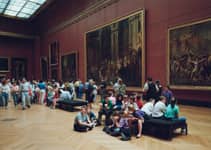 Louvre 1
Louvre 1
Paris
1989
True cat. 4011
Chromogenic impress
180,4 ten 229,7 cm
EXHIBITED: KHZ, KND, MSP
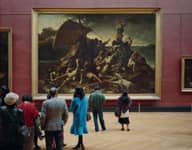 Louvre 4
Louvre 4
Paris
1989
Cat. 4041
Chromogenic print
179,3 x 213,2 cm
EXHIBITED: KHZ, KND, MSP
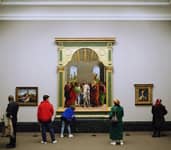 National Gallery 1
National Gallery 1
London
1989
Cat. 4081
Chromogenic print
175,6 ten 191,vii cm
EXHIBITED: KHZ, MSP
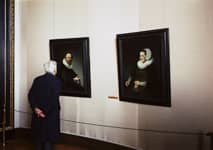 Kunsthistorisches Museum 3
Kunsthistorisches Museum 3
Vienna
1989
Cat. 4111
Chromogenic print
141,five x 183,iv cm
EXHIBITED: KHZ, KND, MSP
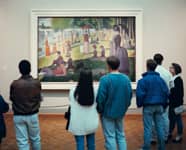
Fine art Institute of Chicago I
Chicago
1990
Cat. 4131
Chromogenic print
171,0 ten 201,v cm
EXHIBITED: KHZ, KND, MSP
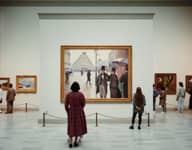
Fine art Institute of Chicago II
Chicago
1990
Cat. 4141
Chromogenic print
180,0 10 215,0 cm
EXHIBITED: KHZ, KND, MSP
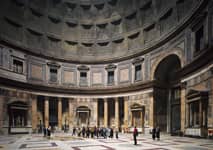 Pantheon
Pantheon
Rome
1990
Cat. 4171
Chromogenic print
179,two ten 233,7 cm
EXHIBITED: KHZ, KND, WGL, MSP
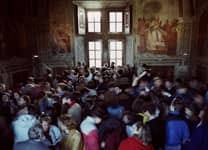 Stanze di Raffaello 2
Stanze di Raffaello 2
Rome
1990
Cat. 4521
Chromogenic print
166,2 x 211,7 cm
EXHIBITED: KHZ
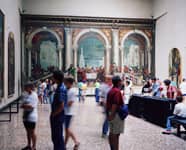 Galleria dell`Accademia i
Galleria dell`Accademia i
Venice
1992
Cat. 4841
Chromogenic print
184,5 10 228,3 cm
EXHIBITED: MSP
Source: https://www.thomasstruth32.com/smallsize/photographs/museum_photographs_1/index.html
0 Response to "Thomas Struth of Interior of Art Institute of Chicago"
Post a Comment